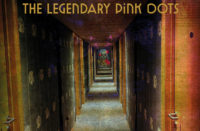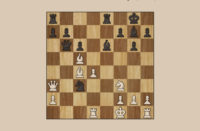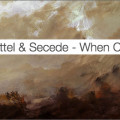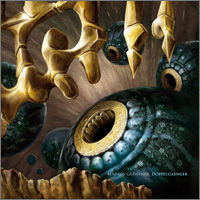
(February 2010) In an attempt to quell the typical, almost rabid clamouring for information and release dates from fans that normally accompany a new Sending Orbs album announcement, the label wisely chose to publicise the details of newly signed Markus Guentner’s Doppelgaenger album far closer to its actual release date than with any of their previous releases. Sending Orbs like to lavish a lot of love upon their infrequent yet always brilliant output meaning that their releases generally take time, so Doppelgaenger came as a welcome surprise at the end of a year that had already seen them put out Yagya’s enchanting Rigning and Kettel’s opus, Myam James 2.
Those already acquainted with Guentner’s work on Ware and Kompakt will be well aware that the term “minimal” is ubiquitously applied to his work, and Sending Orb’s own press-release for the album upholds this trend, describing it as “a field trip into minimal-ambientland”. Field trip, sure, but minimal-ambientland? Don’t let this deceptive terminology fool you: Doppelgaenger is a much broader and more expansive work than that description implies.
In fact opener “Angelpunkt” not only displays few minimal characteristics at all, but is also not what one would strictly call ambient. Having more in common with IDM sensibilities, it could almost be described as out of place as it’s chattering rhythms, hazy pads and buzzing, blurry synth smears sound like nothing else on the album. It’s very upfront and seems to constantly threaten to bloom into something more beat driven, though it never does.
It is with “Das Haus Steht Leer” that the base template is more truly cut for the rest of Doppelgaenger. It could be said of many Sending Orbs releases that the fantastical is a key influence, that they try to forge in the imagination sprawling futuristic or alien worlds, and that Jeroen Advocaat’s accompanying artwork serves to enhance these facets. Doppelgaenger certainly achieves this on many occasions during its seventy-one minute field-trip and in places is arguably more effective at doing so than many previous Sending Orbs releases. It doesn’t do it as consistently though; “Angelpunkt” and “Asphaltwiese” are a little more clinical and “Meer Der Luegen” less compelling fare than other pieces Doppelgaenger.
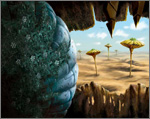
The title track itself could arguably be seen to take a more minimal ambient approach in its construction at least, but again there’s a richness to its presentation that is pitched perfectly. As with “Das Haus Steht Leer” there are bold textures, heady atmospheric pads and sweltering alien sunlight that bathes “Doppelgaenger” in shimmering gold. It also employs repeated, glistening melodic phrases to hypnotising effect, and ends with the mysterious clattering of wooden tribal instruments.
“Dreiglanz” is another highlight. Gently undulating subterranean drones underpin a thick bass-pulse and the chattering of crickets (an overused, often cliche’d choice in ambient works but used very effectively here to help form the rhythmic elements of the piece) coalesce with humid, floral pads that create slowly shifting melodic patterns. The whole taken together evokes lush and superheated, humid tropical islands that are latterly drenched by a rainfall in “Asphaltwiese,” which eschews rhythm in favour of rippling, soft noise and myriad synth droplets.
“Meer Der Luegen” effectively wraps “Asphaltwiese” up in more sub-bass pulses, billowing steam and muffled, thudding Basic Channel beats, then smothers it in gently ringing wind-chimes, but if anything outstays its welcome by being overlong and uneventful, stalling this ambient field-trip at a crucial point.
Luckily “Niederwald” adds some tension and drama as a deeply uneasy ambient drone wells up from the deep, quavering and reverberating like the thrum of a giant insect swarm. Only the regular ring of a tiny synth bell provides any sense of time to the piece as this tide of insects approaches, a writhing mass of whirlwinding sound building to a deafening crescendo as we enter the eye of the storm and then falls away, leaving us in the great exhaled calm of “Toter Hafen.”
If Doppelgaenger‘s construction is minimal this is completely lost on me, as its presentation is anything but. I personally 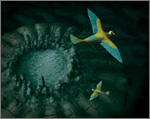 find little that is notably minimal on this varied and fascinating album that truly embodies verdant, perfumed panoramas of alien worlds teeming with extraordinary and exotic wildlife. And while Doppelgaenger may not be as cohesive as the fairy tale worlds explored by Secede or as consistent in theme and texture as Blamstrain’s Disfold or Legiac’s Mings Feaner, it does provide nine wonderfully unrestrained atmospheric moments that each form a discrete and complete experience, which the listener can dip into and savour in whatever measures they wish.
find little that is notably minimal on this varied and fascinating album that truly embodies verdant, perfumed panoramas of alien worlds teeming with extraordinary and exotic wildlife. And while Doppelgaenger may not be as cohesive as the fairy tale worlds explored by Secede or as consistent in theme and texture as Blamstrain’s Disfold or Legiac’s Mings Feaner, it does provide nine wonderfully unrestrained atmospheric moments that each form a discrete and complete experience, which the listener can dip into and savour in whatever measures they wish.
Hopefully this is only the beginning of a greater exploration of the genre by Markus Guentner and that we will hear much more in the future.
Doppelgaenger is out now on Sending Orbs. [Purchase]







